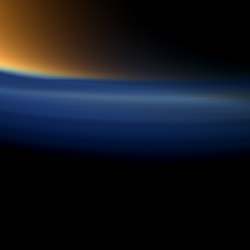[/caption]
It’s been said many times that the most Earthlike world in our solar system is not a planet at all, but rather Saturn’s moon Titan. At first it may not seem obvious why; being only a bit larger than the planet Mercury and coated in a thick opaque atmosphere containing methane and hydrocarbons, Titan sure doesn’t look like our home planet. But once it’s realized that this is the only moon known to even have a substantial atmosphere, and that atmosphere creates a hydrologic cycle on its surface that mimics Earth’s – complete with weather, rain, and gully-carving streams that feed liquid methane into enormous lakes – the similarities become more evident. Which, of course, is precisely why Titan continues to hold such fascination for scientists.
Now, researchers have identified yet another similarity between Saturn’s hazy moon and our own planet: Titan’s energy budget is in equilibrium, making it much more like Earth than the gas giant it orbits.
A team of researchers led by Liming Li of the Department of Earth and Atmospheric Sciences at the University of Houston in Texas has completed the first-ever investigation of the energy balance of Titan, using data acquired by telescopes and the Cassini spacecraft from 2004 to 2010.
Energy balance (or “budget”) refers to the radiation a planet or moon receives from the Sun versus what it puts out. Saturn, Jupiter and Neptune emit more energy than they receive, which indicates an internal energy source. Earth radiates about the same amount as it receives, so it is said to be in equilibrium… similar to what is now shown to be the case for Titan.

The energy absorption and reflection rates of a planet’s – or moon’s! – atmosphere are important clues to the state of its climate and weather. Different balances of energy or changes in those balances can indicate climate change – global cooling or global warming, for instance.
Of course, this doesn’t mean Titan is a balmy world. At nearly 300 degrees below zero (F) it has an environment that even the most extreme Earth-based life would find inhospitable. Although Titan’s atmosphere is ten times thicker than Earth’s its composition is very different, permitting easy passage of infrared radiation (a.k.a. “heat”) and thus exhibits an “anti-greenhouse” effect, unlike Earth or, on the opposite end of the scale, Venus.
Still, some stable process is in place on Saturn’s moon that allows for distribution of solar energy across its surface, within its atmosphere and back out into space. With results due in from Cassini from a flyby on Jan. 2, perhaps there will soon be even more clues as to what that may be.
Read more about Earth’s changing energy budget here.
The team’s report was published in the AGU’s Geophysical Research Letters on December 15, 2011. Li, L., et al. (2011), The global energy balance of Titan, Geophys. Res. Lett., 38, L23201, doi:10.1029/2011GL050053.

